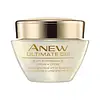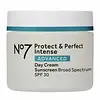What's inside
What's inside
 Key Ingredients
Key Ingredients

 Benefits
Benefits

 Concerns
Concerns

 Ingredients Side-by-side
Ingredients Side-by-side

Water
Skin ConditioningEthylhexyl Methoxycinnamate 5%
UV AbsorberBenzophenone-3 4%
UV AbsorberButyl Methoxydibenzoylmethane 2.9%
UV AbsorberHomosalate
Skin ConditioningGlycerin
HumectantDimethicone
EmollientButylene Glycol
HumectantGlycolic Acid
BufferingBehenyl Alcohol
EmollientHydrogenated Polyisobutene
EmollientTrisiloxane
Skin ConditioningHydroxyethyl Acrylate/Sodium Acryloyldimethyl Taurate Copolymer
Emulsion StabilisingIsononyl Isononanoate
EmollientCetearyl Alcohol
EmollientIsohexadecane
EmollientPhytol
EmollientThiodipropionic Acid
Skin ConditioningPEG-100 Stearate
Ammonium Hydroxide
BufferingCetearyl Glucoside
EmulsifyingPhenoxyethanol
PreservativeDimethiconol
EmollientPolysorbate 60
EmulsifyingDisodium EDTA
PEG-150 Distearate
EmulsifyingCaramel
Cosmetic ColorantParfum
MaskingTiliacora Triandra Leaf/Vine Extract
AntioxidantEclipta Prostrata Extract
Skin ConditioningVitis Vinifera Fruit Cell Extract
Skin ConditioningMaltodextrin
AbsorbentThiazolylalanine
Skin ConditioningIsomalt
HumectantSd Alcohol 40-B
AstringentSaccharomyces/Copper Ferment
Skin ConditioningSaccharomyces/Magnesium Ferment
Saccharomyces/Malachite Ferment
Skin ConditioningSaccharomyces/Tourmaline Ferment
Skin ConditioningSaccharomyces/Zinc Ferment
Skin ConditioningCI 14700
Cosmetic ColorantSteareth-20
CleansingLecithin
EmollientPalmitoyl Tetrapeptide-10
Skin ConditioningPalmitoyl Tetrapeptide-7
Skin ConditioningPalmitoyl Lysyl Aminovaleroyl Lysine
Skin ConditioningWater, Ethylhexyl Methoxycinnamate 5%, Benzophenone-3 4%, Butyl Methoxydibenzoylmethane 2.9%, Homosalate, Glycerin, Dimethicone, Butylene Glycol, Glycolic Acid, Behenyl Alcohol, Hydrogenated Polyisobutene, Trisiloxane, Hydroxyethyl Acrylate/Sodium Acryloyldimethyl Taurate Copolymer, Isononyl Isononanoate, Cetearyl Alcohol, Isohexadecane, Phytol, Thiodipropionic Acid, PEG-100 Stearate, Ammonium Hydroxide, Cetearyl Glucoside, Phenoxyethanol, Dimethiconol, Polysorbate 60, Disodium EDTA, PEG-150 Distearate, Caramel, Parfum, Tiliacora Triandra Leaf/Vine Extract, Eclipta Prostrata Extract, Vitis Vinifera Fruit Cell Extract, Maltodextrin, Thiazolylalanine, Isomalt, Sd Alcohol 40-B, Saccharomyces/Copper Ferment, Saccharomyces/Magnesium Ferment, Saccharomyces/Malachite Ferment, Saccharomyces/Tourmaline Ferment, Saccharomyces/Zinc Ferment, CI 14700, Steareth-20, Lecithin, Palmitoyl Tetrapeptide-10, Palmitoyl Tetrapeptide-7, Palmitoyl Lysyl Aminovaleroyl Lysine
Water
Skin ConditioningGlycerin
HumectantC12-15 Alkyl Benzoate
AntimicrobialOctocrylene
UV AbsorberButyl Methoxydibenzoylmethane
UV AbsorberCetearyl Glucoside
EmulsifyingDimethicone
EmollientAluminum Starch Octenylsuccinate
AbsorbentEthylhexyl Salicylate
UV AbsorberAlcohol Denat.
AntimicrobialButylene Glycol
HumectantAmmonium Acryloyldimethyltaurate/Vp Copolymer
Phenoxyethanol
PreservativeTribehenin
EmollientButyrospermum Parkii Butter
Skin ConditioningBis-Ethylhexyloxyphenol Methoxyphenyl Triazine
Skin ConditioningPotassium Cetyl Phosphate
EmulsifyingMethylparaben
PreservativeDimethiconol
EmollientParfum
MaskingPropylene Glycol
HumectantXanthan Gum
EmulsifyingTocopheryl Acetate
AntioxidantSodium Hyaluronate
HumectantEthylparaben
PreservativeDiethylhexyl Butamido Triazone
UV AbsorberAscorbyl Glucoside
AntioxidantDipropylene Glycol
HumectantRetinyl Palmitate
Skin ConditioningHydrolyzed Rice Protein
Skin ConditioningTetrasodium EDTA
Sorbitan Laurate
EmulsifyingT-Butyl Alcohol
PerfumingPanax Ginseng Root Extract
EmollientCarbomer
Emulsion StabilisingDimethylmethoxy Chromanol
AntioxidantPotassium Hydroxide
BufferingMedicago Sativa Extract
TonicPolysorbate 20
EmulsifyingHydroxyethylcellulose
Emulsion StabilisingMorus Alba Leaf Extract
Skin ConditioningSilica
AbrasiveSodium Benzoate
MaskingTocopherol
AntioxidantAcetyl Dipeptide-1 Cetyl Ester
Skin ConditioningEthylhexylglycerin
Skin ConditioningPalmitoyl Tripeptide-1
Skin ConditioningPalmitoyl Tetrapeptide-7
Skin ConditioningWater, Glycerin, C12-15 Alkyl Benzoate, Octocrylene, Butyl Methoxydibenzoylmethane, Cetearyl Glucoside, Dimethicone, Aluminum Starch Octenylsuccinate, Ethylhexyl Salicylate, Alcohol Denat., Butylene Glycol, Ammonium Acryloyldimethyltaurate/Vp Copolymer, Phenoxyethanol, Tribehenin, Butyrospermum Parkii Butter, Bis-Ethylhexyloxyphenol Methoxyphenyl Triazine, Potassium Cetyl Phosphate, Methylparaben, Dimethiconol, Parfum, Propylene Glycol, Xanthan Gum, Tocopheryl Acetate, Sodium Hyaluronate, Ethylparaben, Diethylhexyl Butamido Triazone, Ascorbyl Glucoside, Dipropylene Glycol, Retinyl Palmitate, Hydrolyzed Rice Protein, Tetrasodium EDTA, Sorbitan Laurate, T-Butyl Alcohol, Panax Ginseng Root Extract, Carbomer, Dimethylmethoxy Chromanol, Potassium Hydroxide, Medicago Sativa Extract, Polysorbate 20, Hydroxyethylcellulose, Morus Alba Leaf Extract, Silica, Sodium Benzoate, Tocopherol, Acetyl Dipeptide-1 Cetyl Ester, Ethylhexylglycerin, Palmitoyl Tripeptide-1, Palmitoyl Tetrapeptide-7
Ingredients Explained
These ingredients are found in both products.
Ingredients higher up in an ingredient list are typically present in a larger amount.
Also known as Avobenzone, this ingredient is a chemical sunscreen filter that provides protection in the UV-A range.
Avobenzone is globally approved and is the most commonly used UV-A filter in the world.
Studies have found that avobenzone becomes ineffective when exposed to UV light (it is not photostable; meaning that it breaks down in sunlight). Because of this, formulations that include avobenzone will usually contain stabilizers such as octocrylene.
However, some modern formulations (looking at you, EU!) are able to stabilize avobenzone by coating the molecules.
Avobenzone does not protect against the UV-B range, so it's important to check that the sunscreen you're using contains other UV filters that do!
The highest concentration of avobenzone permitted is 3% in the US, and 5% in the EU.
Learn more about Butyl MethoxydibenzoylmethaneButylene Glycol (or BG) is used within cosmetic products for a few different reasons:
Overall, Butylene Glycol is a safe and well-rounded ingredient that works well with other ingredients.
Though this ingredient works well with most skin types, some people with sensitive skin may experience a reaction such as allergic rashes, closed comedones, or itchiness.
Learn more about Butylene GlycolCetearyl Glucoside is a surfactant and emulsifier. It can be produced from synthetic of natural sources of cetearyl alcohol and glucose.
Emulsifiers help prevent ingredients from separating, such as oils and waters. It can also be used to enhance the texture of products.
As a surfactant, Cetearyl Glucoside helps during the cleansing process. By gathering all the dirt and oils, it allows these molecules to be washed away easily.
Learn more about Cetearyl GlucosideDimethicone is a type of synthetic silicone created from natural materials such as quartz.
What it does:
Dimethicone comes in different viscosities:
Depending on the viscosity, dimethicone has different properties.
Ingredients lists don't always show which type is used, so we recommend reaching out to the brand if you have questions about the viscosity.
This ingredient is unlikely to cause irritation because it does not get absorbed into skin. However, people with silicone allergies should be careful about using this ingredient.
Note: Dimethicone may contribute to pilling. This is because it is not oil or water soluble, so pilling may occur when layered with products. When mixed with heavy oils in a formula, the outcome is also quite greasy.
Learn more about DimethiconeDimethiconol is a silicone that resembles the popular dimethicone. Like other silicones, it is an emollient. Emollients create a thin film on skin to prevent moisture from escaping.
This ingredient helps to create a silky texture and improve spreadability. Due to its high molecular weight and thickness, it is often combined with cyclopentasiloxane.
Glycerin is already naturally found in your skin. It helps moisturize and protect your skin.
A study from 2016 found glycerin to be more effective as a humectant than AHAs and hyaluronic acid.
As a humectant, it helps the skin stay hydrated by pulling moisture to your skin. The low molecular weight of glycerin allows it to pull moisture into the deeper layers of your skin.
Hydrated skin improves your skin barrier; Your skin barrier helps protect against irritants and bacteria.
Glycerin has also been found to have antimicrobial and antiviral properties. Due to these properties, glycerin is often used in wound and burn treatments.
In cosmetics, glycerin is usually derived from plants such as soybean or palm. However, it can also be sourced from animals, such as tallow or animal fat.
This ingredient is organic, colorless, odorless, and non-toxic.
Glycerin is the name for this ingredient in American English. British English uses Glycerol/Glycerine.
Learn more about GlycerinPalmitoyl Tetrapeptide-7 (formerly Palmitoyl Tetrapeptide-3) is a lab-made peptide with anti-inflammatory and skin-repairing benefits. It's made up of four amino acids (glycine, glutamine, proline, and arginine) and palmitic acid (which helps it penetrate skin more effectively).
This ingredient helps reduce inflammation by limiting the production of interleukin-6 (IL-6), a chemical that triggers inflammatory responses, particularly after UV exposure.
Less inflammation = slower collagen breakdown and a longer-lasting, youthful appearance.
Palmitoyl Tetrapeptide-7 also stimulates collagen production and supports a healthier skin barrier.
Over time, this can improve skin firmness, hydration, and reduce the appearance of fine lines. It’s commonly paired with Palmitoyl Tripeptide-1 in the well-known Matrixyl 3000 complex for enhanced anti-aging effects.
This ingredient has been shown to be effective and safe in cosmetic use and you'll typically find it in small amounts (less than 0.01%).
Due to its palmitic acid base, it may not be safe for Malassezia folliculitis.
Read more about other common types of peptides here:
Learn more about Palmitoyl Tetrapeptide-7Parfum is a catch-all term for an ingredient or more that is used to give a scent to products.
Also called "fragrance", this ingredient can be a blend of hundreds of chemicals or plant oils. This means every product with "fragrance" or "parfum" in the ingredients list is a different mixture.
For instance, Habanolide is a proprietary trade name for a specific aroma chemical. When used as a fragrance ingredient in cosmetics, most aroma chemicals fall under the broad labeling category of “FRAGRANCE” or “PARFUM” according to EU and US regulations.
The term 'parfum' or 'fragrance' is not regulated in many countries. In many cases, it is up to the brand to define this term.
For instance, many brands choose to label themselves as "fragrance-free" because they are not using synthetic fragrances. However, their products may still contain ingredients such as essential oils that are considered a fragrance by INCI standards.
One example is Calendula flower extract. Calendula is an essential oil that still imparts a scent or 'fragrance'.
Depending on the blend, the ingredients in the mixture can cause allergies and sensitivities on the skin. Some ingredients that are known EU allergens include linalool and citronellol.
Parfum can also be used to mask or cover an unpleasant scent.
The bottom line is: not all fragrances/parfum/ingredients are created equally. If you are worried about fragrances, we recommend taking a closer look at an ingredient. And of course, we always recommend speaking with a professional.
Learn more about ParfumPhenoxyethanol is a preservative that has germicide, antimicrobial, and aromatic properties. Studies show that phenoxyethanol can prevent microbial growth. By itself, it has a scent that is similar to that of a rose.
It's often used in formulations along with Caprylyl Glycol to preserve the shelf life of products.
Water. It's the most common cosmetic ingredient of all. You'll usually see it at the top of ingredient lists, meaning that it makes up the largest part of the product.
So why is it so popular? Water most often acts as a solvent - this means that it helps dissolve other ingredients into the formulation.
You'll also recognize water as that liquid we all need to stay alive. If you see this, drink a glass of water. Stay hydrated!
Learn more about Water